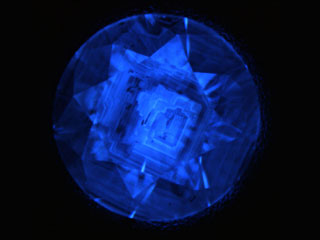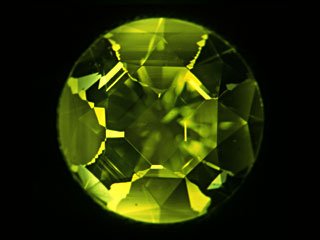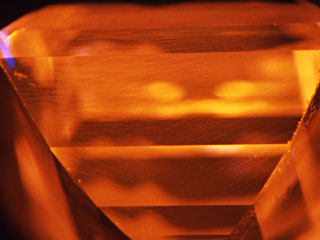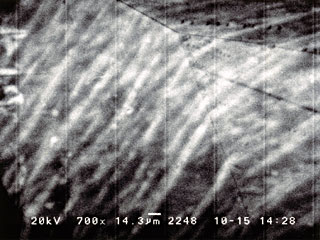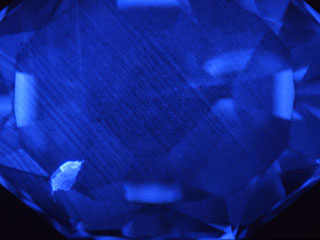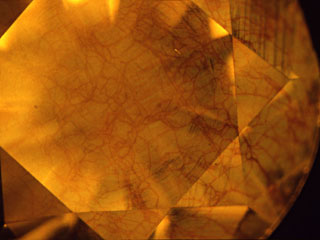| Cathode Luminescence (CL) Cathode luminescence technique can observe growth history of a diamond and this is the most effective means to reveal the origin of a diamond. In this study, two types, a luminoscope ELM-3 and a combination of an electron microscope and a spectroscope, were used. The former can observe emission colour directly, while the latter have higher resolving power of CL figure. The Diamond View developed by DTC employs shorter wave ultraviolet light instead of electron beam in CL technique, and its principle is very similar to a luminoscope. The Diamond View has better operationality but CL method can provide clearer image of fluorescence image. CL images of natural diamond are variable and they can even be applied to individual identification (Photo 10). Synthetic diamonds produced by HPHT technique show sector zoning (Photo 11), which makes distinction from natural diamonds easier.
In most of type II natural diamonds, spotted or linear (due to dislocation) dark-blue emission colour called band-A is observed (Photo 14). Rarely orange emission colour due to NV centre may be observed in some stones, which will show mosaic pattern that is not seen in CVD diamond (Photo 15).
Gemmological study was made on CVD synthetic diamonds, which are difficult in most cases to distinguish from natural diamonds by general identification tests only. However, characteristic orange fluorescence and absence of anomalous double refraction due to strain called eTatamif structure that is commonly seen in type IInatural diamonds are important clues for synthetic origin. Photoluminescence analysis under very low temperature may reveal some characteristic features that are not observed in natural diamonds. By Cathode Luminescence (CL) analysis, growth structure unique to CVD diamonds makes the stones positively distinguishable from natural diamonds. Application of CVD diamonds to jewellery has just started and its production is limited at the moment, but a possibility of application of CVD diamond to engineering field widely indicates further technical development. The identifying features explained in this report are based upon current products and gemmological laboratories must make efforts continuously to develop identification technique for such new material. Acknowledgement We express our special thanks to Dr. Simon C. Lawson and Dr. Philip M. Martineau of DTC Research Centre for providing us of opportunity to analyse CVD diamonds of Element Six, to Mr. Branko Deljanin of European Gemological Laboratory (EGL) for lending us CVD diamond samples of Apollo Diamond inc., and to Dr. Hisao Kanda of the National Institute of Materials Science for cooperating our CL observation by an electron microscope. References On preparing this report, we referred to many literatures, major ones of which are listed below:
*: AGL regulates that synthetic diamonds should not be graded. |
|||||||||||||||||||||||||||||||||||||||||
|
|||||||||||||||||||||||||||||||||||||||||
